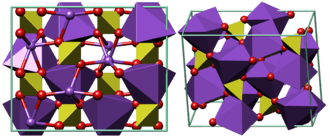Thenardite
| Thenardite | |
|---|---|
|
Sodaville, Mineral County, Nevada | |
| General | |
| Category | Sulfate mineral |
| Formula (repeating unit) | Na2SO4 |
| Strunz classification | 07.AC.25 |
| Crystal symmetry |
Orthorhombic dipyramidal H-M symbol: (2/m 2/m 2/m) Space group: F ddd |
| Unit cell | a = 5.86 Å, b = 12.3 Å, c = 9.82 Å; Z=8 |
| Identification | |
| Formula mass | 142.04 |
| Color | White, grayish white, yellowish white, reddish white, brownish white |
| Crystal habit | Forms crust-like prismatic aggregates on matrix |
| Crystal system | Orthorhombic |
| Twinning | Interpenetration twinning on {001}; also on {100} |
| Cleavage | {010} Perfect |
| Fracture | Splintery |
| Tenacity | Brittle |
| Mohs scale hardness | 2.5 |
| Luster | Vitreous to resinous |
| Streak | White |
| Diaphaneity | Transparent |
| Specific gravity | 2.67–2.7, average = 2.68 |
| Optical properties | Biaxial (+) |
| Refractive index | nα = 1.471, nβ = 1.477, nγ = 1.484 |
| Birefringence | δ = 0.013 |
| Pleochroism | none |
| 2V angle | 83° |
| Ultraviolet fluorescence | Fluorescent and phosphorescent: short UV=bright white, long UV=bright white |
| Solubility | Soluble in water |
| Other characteristics | Salty taste |
| References | [1][2][3] |
Thenardite is an anhydrous sodium sulfate mineral, Na2SO4 which occurs in arid evaporite environments. It also occurs in dry caves and old mine workings as an efflorescence and as a crusty sublimate deposit around fumaroles. It occurs in volcanic caves on Mt. Etna, Italy. It was first described in 1825 for an occurrence in the Espartinas Saltworks, Ciempozuelos, Madrid, Spain and was named for the French chemist, Louis Jacques Thénard (1777–1826).[2]
Thenardite crystallizes in the orthorhombic system and often forms yellowish, reddish to grey white prismatic crystals although usually in massive crust deposits. Thenardite is fluorescent, white in shortwave and yellow-green in longwave UV radiation.
In humid conditions, thenardite gradually absorbs water and converts to the mineral mirabilite, Na2SO4·10H2O.

References
| Wikimedia Commons has media related to Thenardite. |
